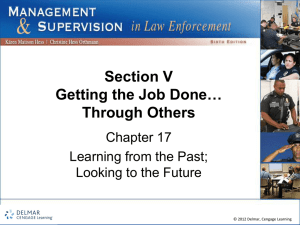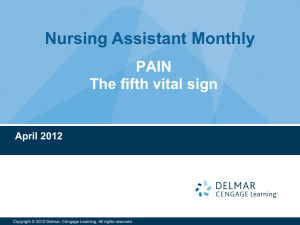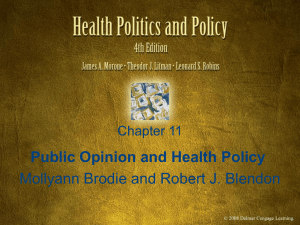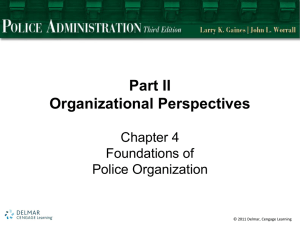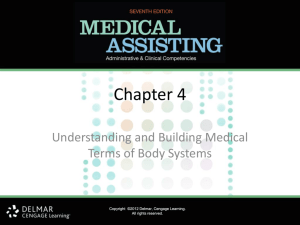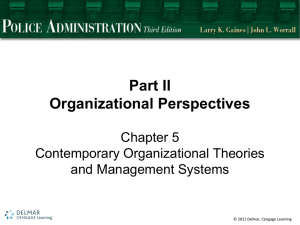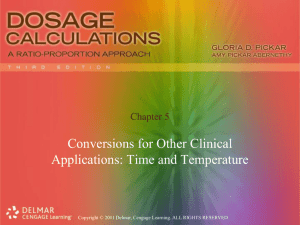CHAPTER 17: CPT PATHOLOGY/LABORATORY
advertisement
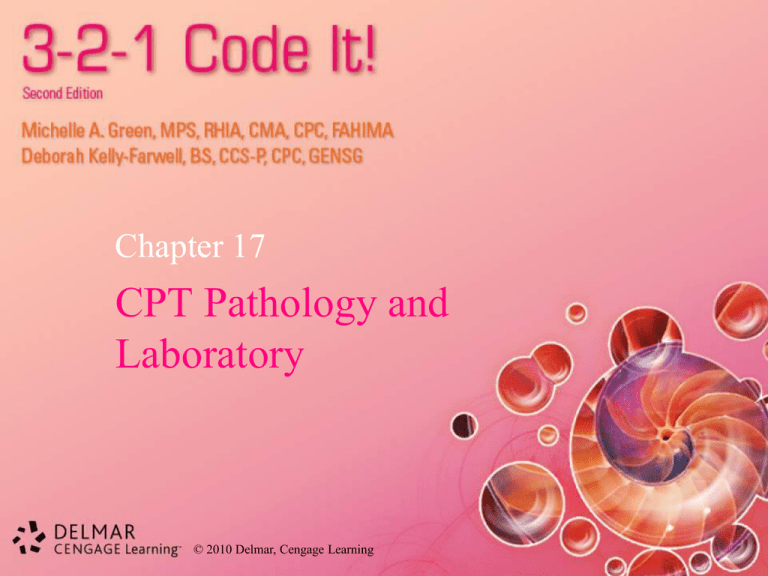
Chapter 17 CPT Pathology and Laboratory © 2010 Delmar, Cengage Learning Subsections • • • • • • Organ or disease-oriented panels Drug testing Therapeutic drug assays Evocative/Suppression testing Consultations (clinical pathology) Urinalysis © 2010 Delmar, Cengage Learning (continued) Subsections • • • • • • Chemistry Hematology and coagulation Molecular diagnostics Transfusion medicine Microbiology Anatomic pathology © 2010 Delmar, Cengage Learning Subsections • • • • • • Cytopathology Cytogenetic studies Surgical pathology Transcutaneous procedures Other procedures Reproductive medicine procedures © 2010 Delmar, Cengage Learning Overview of Pathology and Laboratory Section • Describes services performed on specimens (e.g., body fluids, tissue, cytological specimens) to evaluate, prevent, diagnose, or treat disease © 2010 Delmar, Cengage Learning Laboratory Examinations • • • • • Biophysical Chemical Cytological Hematological Immunohematological © 2010 Delmar, Cengage Learning (continued) Laboratory Examinations • Microbiological • Pathological • Serological © 2010 Delmar, Cengage Learning Laboratory Service Codes • Most clinical laboratory service codes include a technical component. • Some services include both a technical and professional component. © 2010 Delmar, Cengage Learning Exercise 17.1 1. Although most clinical laboratory service codes include a technical component, some include both a technical and a __________ component. © 2010 Delmar, Cengage Learning Pathology and Laboratory Sections • Organization – According to procedure performed – Procedures listed alphabetically within each subsection • Review patient record documentation, code descriptions, and instructional notes • Hospitals include pathology and laboratory codes on a chargemaster, which is used to report services and supplies for inpatient, outpatients and emergency department patients. © 2010 Delmar, Cengage Learning Exercise 17.1 2. Review of patient record documentation is necessary before assigning pathology and laboratory codes because many procedures can be performed using different ________. © 2010 Delmar, Cengage Learning Exercise 17.1 3. Hospital codes usually do not assign pathology and laboratory codes because they are included on a __________________, which is used by providers to select services provided to patients. © 2010 Delmar, Cengage Learning Specimen Collection • Laboratory codes describe performance of lab tests • Codes do not include collection of specimen (reported separately) © 2010 Delmar, Cengage Learning Exercise 17.1 4. CPT laboratory codes describe the performance of lab tests, and they do not include collection of the _________, which is performed using different methods (e.g., venipuncture, fingerstick, or lumbar puncture ) and is reported separately. © 2010 Delmar, Cengage Learning Exercise 17.1 5. The puncture of a vein using a needle for the purpose of drawing blood as a common method of collecting blood specimens is called venipuncture, or ___________________. © 2010 Delmar, Cengage Learning Professional and Technical Components • Certain laboratory procedures contain both a professional (e.g., physician) and technical component – Technical component includes cost of equipment, supplies, and technician salaries © 2010 Delmar, Cengage Learning Exercise 17.1 6. A routine venipuncture (usually performed by a nurse) is assigned code __________, and it is reported in addition to the laboratory procedure code. © 2010 Delmar, Cengage Learning Exercise 17.1 7. When a physician’s sill is required to perform the procedure, a code from range __________ is assigned. © 2010 Delmar, Cengage Learning Coding Tip • When pathology/laboratory service code description includes both the technical and professional component, and both components were not performed, report the appropriate code with its modifier: – -26 (professional component only provided) – -TC (technical component only provided) © 2010 Delmar, Cengage Learning Exercise 17.1 8. When a pathology and laboratory procedure code description includes technical and professional components, and both components were not performed, modifier _________ is added to the code to indicate that only the professional component was performed. © 2010 Delmar, Cengage Learning Clinical Pathology • Professional services include: – Directing and evaluating quality assurance and control procedures – Supervising laboratory technicians – Recommending follow-up diagnostic tests © 2010 Delmar, Cengage Learning Coding Tip • Modifier -90 [reference (outside) laboratory] is reported to indicate that an outside laboratory performed the service. © 2010 Delmar, Cengage Learning Exercise 17.1 9. When an outside laboratory performs pathology and laboratory services, add modifier ________ to a reported code. © 2010 Delmar, Cengage Learning Clinical Laboratory Improvement Act (CLIA) • Physician office labs must obtain certification to: – Perform certain pathology and laboratory tests – Submit claims to Medicare and Medicaid © 2010 Delmar, Cengage Learning Exercise 17.1 10.To perform certain pathology and laboratory tests (and to submit claims to Medicare and Medicaid), physician office labs must obtain certification under the _____________. © 2010 Delmar, Cengage Learning Coding Tip • When reporting CLIA-waived services to Medicare or Medicaid, add HCPCS level II modifier -QW to pathology and laboratory codes. © 2010 Delmar, Cengage Learning National Coverage Determinations (NCD) • Define coverage for services and procedures • Developed by CMS to: – Simplify administrative requirements for clinical diagnostic services – Promote national uniformity in processing Medicare claims • Medicare administrative contractors apply NCDs nationwide © 2010 Delmar, Cengage Learning Pathology and Laboratory Section Guidelines • Located at beginning of Pathology and Laboratory section • Provide instruction about: – – – – – Services for pathology and laboratory Separate or multiple procedures Subsection information Unlisted services or procedures Special reports © 2010 Delmar, Cengage Learning Exercise 17.2 1. The unit of pathology service is a _______, which is tissue submitted for individual and separate examination and pathological diagnosis. © 2010 Delmar, Cengage Learning Exercise 17.2 2. During the same operative session, the surgeon Submitted “incidental appendix” tissue and a Section of fallopian tube (as a result of a sterilization procedure) for pathological evaluation. Refer to the notes located below the Surgical Pathology subsection (codes 88300-88399) To determine whether one or two codes are reported. Code 88302 is reported _________ (once/twice). © 2010 Delmar, Cengage Learning Exercise 17.2 3. It is appropriated to separately code and report multiple pathology and laboratory procedures that are provided on the same _____________. © 2010 Delmar, Cengage Learning Special Report • Submitted when unlisted procedure or service code is reported on claim • Attached to submitted claim to clarify service or procedure performed • Should include description of nature, extent, and need for procedure © 2010 Delmar, Cengage Learning (continued) Exercise 17.2 4. A service or procedure that is provided for which there is no CPT code is reported with an ______________ code , and a __________ is attached to the submitted claim. © 2010 Delmar, Cengage Learning Special Report • May include: – – – – – – Complexity of symptoms Final diagnosis Pertinent physical findings Diagnostic and therapeutic procedures Concurrent problems Follow-up care © 2010 Delmar, Cengage Learning Modifiers • -51 (multiple procedures) – Not added to pathology and laboratory codes • -91 (repeat clinical diagnostic laboratory test) – Added when procedures or services are repeated on same date of service in order to obtain multiple results © 2010 Delmar, Cengage Learning Exercise 17.2 5. When procedures or services are repeated on the same date of service to obtain multiple results, add modifier _________ to the reported pathology and laboratory codes. it is not appropriated to add modifier ______ to pathology and laboratory codes. © 2010 Delmar, Cengage Learning
